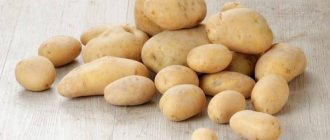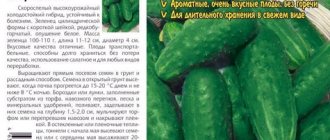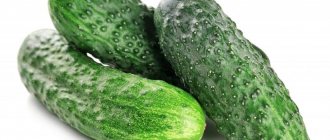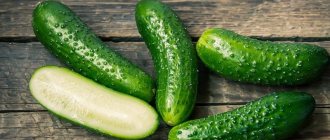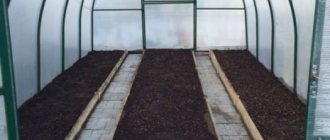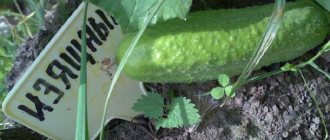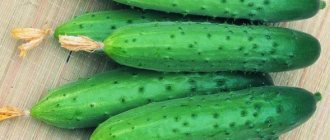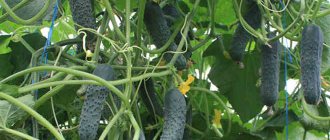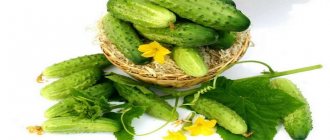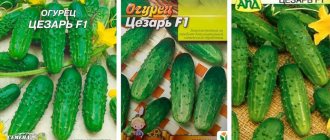Mumu F1 cucumber is suitable for pickling for the winter, but above all it is good in salads. Greens of medium length can be collected ripe or slightly undergrown, at the gherkin stage. They have a wonderful taste, an appetizing aroma, and the yield is large enough so that the family does not have a shortage of fresh fruits.
| Landing location | Ripening time | Mode of application | Fruit length | Group | Fruit smoothness | Pollination method |
| Universal | Early ripening (35-45 days) | Universal | Medium - from 10 to 15 cm | Hybrid | Slightly lumpy | Parthenocarpic |
Variety criteria
For any summer resident there is never too much information; before planting a new variety on the site, they look for more detailed information about the hybrid. Then they decide whether the variety is suitable for cultivation or not.
Plant:
- Parthenocarpic.
- Vigorous.
- Medium branched.
- Determinate structure.
- There are 4-6 cucumbers in one node.
- Ripens within 43-48 days.
Fruit:
- Shape: oblong.
- Color: rich green with small light stripes.
- Pubescence: dark.
- Length: 10-12 cm.
- Weight: 100 g.
- Taste without characteristic bitterness, even with a lack of moisture.
- It stores well and withstands long-term transportation while maintaining its commercial qualities.
The description of the variety reveals the general indicators that summer residents most often pay attention to.
Cucumber variety Vyaznikovsky 37
One of the oldest, but very well-deserved cucumber varieties in Russia is Vyaznikovsky 37. It was taken as the basis for many subsequent types of this crop, bred by domestic breeders. Our hero comes from the city of Vyazniki, in the Vladimir region, hence the name. Its selection took place by selecting the best specimens from local varieties of Vyaznikovsky cucumbers. An application for registration of the variety was submitted in 1937. It was included in the State Register of Breeding Achievements in 1943. Originator: Federal State Budgetary Institution "Federal Scientific Center for Vegetable Growing". Admission regions: Central, Northern, Northwestern, Middle Volga, Volga-Vyatka, Ural, West Siberian and East Siberian. The variety is recommended for growing in open ground. Ideal for conditions in central Russia. Cucumber shows excellent results when grown in film greenhouses; in this case, the crop ripens even earlier. Not a hybrid.
Growing on site
Mumu is a hybrid that is planted in two ways, direct sowing in the ground and seedling method. Direct sowing of the soil is carried out after the soil has warmed up to + 18 ⁰С. The main condition is no frost; cucumber culture cannot tolerate this.
Humus and wood ash are added to the holes, and after sowing they are covered with polyethylene or glass until shoots emerge. Further care is the same as with the second growing method.
Most summer residents practice growing cucumbers using the seedling method. Thus, it is possible to reduce the period before fruiting begins by 2-3 weeks. Seedlings require high-quality care. Because healthy seedlings are the key to a rich harvest in the future.
See also
Why do cucumbers take a long time to sprout in open ground and what to doRead
Observe the temperature regime, +20-22 ⁰С. Lighting is required for 14-16 hours a day. Seeds are sown 3 weeks before planting in a permanent place. Each summer resident calculates the period individually, since the climate is different.
Transplantation into the ground is carried out as follows, since Mumu has a determinant type of bush structure and is planted denser than other varieties. There are 6-8 plants per 1 m2.
Be careful when replanting the roots of the crop. Cucumbers are very vulnerable in this regard; a damaged root system leads to the death of the plant.
It is better to use peat pots or easily breakable containers for growing seedlings, which can be removed without damaging the roots.
Agricultural technology
According to professionals, cultivating cucumber crops is quite simple. However, without knowing the intricacies, the vegetable grower will not see a rich harvest of delicious, healthy cucumbers. Beginners who plan to collect at least several kg of cucumbers from each bush need to know that this vegetable is very heat-loving, loves moisture, and a sufficient amount of light.
The cucumber crop is unpretentious to the soil, but bears fruit more actively on light sandy, loamy substrates with a low pH level. This type of soil is different:
- air permeability;
- ability to quickly absorb liquid.
The hybrid does not like the presence of groundwater near the rhizome. How he cannot tolerate planting in those beds where they grew before:
- beet;
- pumpkin crops.
Planting a plant in the ground has important subtleties. It is better to do this when the soil has already warmed up and the temperature has reached approximately +15–17 °C. It would be correct if the gardener prepares holes with an interval of about 500 mm for sowing the seed; it would be good if it were three rows.
You can use a trellis - then the required distance between the holes is 200 mm, and between the rows - 300–400 mm. In such a situation, the seeding depth should be approximately 20 mm, and there should be 4–5 seeds per hole.
The general rule is that when using non-seedling methods, it is rational to use pre-soaked seed material. It is necessary to regularly thin out the sprouts so that weak seedlings do not take away moisture and minerals from stronger, healthier ones. Weak plants should not be pulled out, but cut off. This will make it possible not to injure the rhizomes of other seedlings.
It is necessary to carefully pinch the top, the bud - but do this when 4-5 leaves have formed. This will seriously accelerate the development of inflorescences and ovaries.
Without heat, a hybrid culture will not fully develop. Cucumbers are afraid of night frosts and when the temperature drops to 15 °C, they slow down their development, and when the temperature drops to 10 °C, they completely stop growing. To ensure normal conditions, the cucumber crop requires an air temperature of 25–30 °C and air humidity of at least 70%.
You may be interested in:
Cucumber Masha f1: description and characteristics, reviews Cucumber Masha f1 is a Dutch hybrid of the first generation. This variety has been listed in the State Register since 2000, now it’s time to plant it...Read more...
Subtleties of watering and fertilizing
You need to water regularly. So, before flowering, they moisten moderately, spending 3-6 liters per 1 m2. This irrigation is needed every 7 days. During flowering and appearance of cucumbers, it is necessary to water abundantly - approximately a bucket per 1 m2, every 2 days. It is the hydration that determines whether the fruits will taste bitter. If you dry out the soil once, bitterness will appear in all subsequent cucumbers. When fielding, it is important to take warm water at room temperature, and do this after sunset.
On a note!
Watering should be done using a watering can with a sprayer. If you irrigate with a stream, you can damage the rhizome.
By the end of the growing season, there is no need to irrigate the plantings much, and the frequency should be reduced significantly. The hybrid needs to be fed. Without fertilizers you cannot get a good harvest. The feeding rules must be followed.
You can use wood ash for cucumber seedlings in a greenhouse or in gardens without shelter, starting with:
- pre-sowing treatment of seed material;
- filling the soil during its preparation;
- planting cucumbers.
Phosphorus-potassium fertilizers are applied at various stages of their growth. The most important condition for using this fertilizer, which is beneficial for vegetables, is that it cannot be combined with other organic matter (especially with fresh slurry and chicken droppings) or minerals, but it is allowed to alternate them.
Dry wood ash, in powder form, can be used for autumn or spring soil cultivation in the garden allocated for cucumber plantings. To do this, the powder must be added to the soil after digging it, combining it with compost in the proportions of 100 g for each square area of cucumber beds. Ash powder added to soil:
- will contribute to an increase in the activity of beneficial organisms inhabiting it;
- will attract earthworms that process organic matter in the ground.
This makes the soil more loose and enriched with useful elements. You can also add ash powder when planting seeds or seedlings directly into the holes. To do this, add 2 tablespoons of the drug to each hole and then connect it to the soil.
On a note!
This organic matter can also be used for adult bushes. To do this, you just need to pour 100 g of dry ash per m2 of planting under the cucumbers, and then thoroughly water the beds with warm water.
Ash powder is not only an excellent top dressing, but also an excellent prevention and cure for scab and aphids, which often attack cucumber crops in garden beds and especially in greenhouses. To do this, sift the ash through a sieve and cover the cucumber plantings with ash. The remedy also helps against slugs; to do this, you need to sprinkle it on the ground around it.
In a liquid state, in an aqueous solution, the ash preparation is also actively used for feeding cucumber hybrids. To process seed material it is necessary:
- take a tablespoon of ash;
- dilute it in 2 liters of water;
- leave to stand for 48 hours.
After this, the prepared composition must be filtered, then the seed material must be soaked in it for 5 hours. This will increase germination, and cucumber sprouts will become strong and healthy, and will develop more actively. You can fertilize cucumber crops with ash already at the seedling stage, in the development phase of 2-3 true leaves and throughout the entire growing season.
For the first feeding of Mumu, you need to make a nutrient solution. Take 10 tablespoons of dry ash, dilute it in a bucket of warm water and leave to stand for 7 days. After this, the preparation is filtered and the plantings are watered, pouring a liter of liquid under each bush. It is necessary to feed with this product no more than once every 7 days.
In the same proportions, ash powder is diluted to feed cucumber seedlings when the flowering period begins. When the plant crop begins to actively bear fruit, it is necessary to make another nutrient solution for it. Take 3 tablespoons of dry ash and add 3 liters of water, boil for half an hour. After it cools, filter and bring the volume to a bucket, adding water. This drug is used to treat plantings from a spray bottle. You can fertilize this way several times throughout the season, approximately every week and a half, until the very end of the growing season.
Care
Mandatory work is weed control. Both weeding and loosening of the soil are simply necessary for hybrid cucumber plants. However, it is important to understand that the rhizome of Mumu F1 can be easily injured, since it is located very close to the top of the soil. Therefore, if the gardener is afraid of harming the plantings, you can simply apply mulch. If the vegetable grower does everything according to the rules, the yield will only increase.
Note!
You need to be able to harvest the harvest well - you need to prevent the cucumbers from drying out and collect the gherkins as they ripen. This will increase the amount of the total harvest.
On bunches of cucumber hybrids, the ovaries often dry out, since the plants cannot feed such a large number of them. To prevent this, it is necessary to follow the following care measures:
- A week and a half before planting the seedlings, prepare the bed by adding up to 15 kg of compost and 2 spoons of minerals per m2 for digging.
- Plants are planted when the soil at a depth of 100 mm warms up to +10 °C. 24 hours before planting, water the bed well.
- Since bunch hybrids do not like crowding, they are planted in one row with an interval of 400 mm. Before planting, add up to a liter of warm pink manganese solution to each hole.
- The seedling material is watered 2 hours before transplanting. They are planted together with a ball of soil, without deepening it - the plant is lightly pressed with soil and sprinkled with humus and a peat mixture.
- In the greenhouse, the air humidity level is maintained at about 95%. The temperature during planting is +22 °C, during flowering about +28.
The lashes must be tied to the trellis - pull two wires at a height of 2 m and 300 mm from each other. Tie twine to the wire. Secure it under the first pair of sheets with a free loop. They tie one bush on one wire, and another on the second, and so on. Leave about 200 mm of free twine so that you can loosen the garter later. The twine is wrapped around the plant crop by the hour. When the seedlings reach the wire, the whip is wrapped around it twice, then secured with a figure eight. When a pair of leaves and a bunch of cucumbers are formed, the top is pinched.
Note!
Bunches of cucumbers are formed in a special way. It is important to remove flowers and shoots in the axils of the first 4 leaves. Next, you need to remove all the shoots from the side almost to the trellis.
It is allowed to leave 2-3 shoots with ovaries nearby, pinching them over the second leaf. The main thing in forming a bush in this way is to collect as many fruits as possible from the central stem.
On warm days, water with settled water, after which the plantings are loosened:
- before fruit delivery once every 7 days;
- every 3 days thereafter.
Every 14 days they feed with organic matter:
- chicken manure solution 1:20;
- manure 1:10.
And complex minerals (one and a half spoons per bucket of water). Irrigate with Zircon and Epin 2 times to increase resistance to stressful situations and better filling of cucumbers - at the beginning of the opening of buds and during flowering.
You may be interested in:
Cucumber Miranda f1: description and characteristics, reviews The cucumber variety Miranda F1 was bred in the 90s in Russia, and in 2003 it was included in the list most often...Read more...
Small cucumbers are harvested every 2 days. At the end of fruit production, the old canes are cut off and the plantings are treated with urea - young shoots are formed and a few cucumbers are produced again.
Cucumbers are good for health, they have a positive effect on the digestive system and lead to the complete absorption of other foods. The potassium contained in cucumbers is good for the functioning of the heart and kidneys. Gherkins have a diuretic, laxative and choleretic effect. For tired eyes and redness of the eyelids, apply chopped cucumber slices to them or make a compress from the juice.
Taking care of plantings
Further care consists of watering, which is carried out in the evening, preferably with warm water. Drip irrigation of cucumber bushes works perfectly for this purpose. All the moisture necessary for plant growth goes directly to the roots.
Loosening will provide oxygen access to the root system and help retain moisture longer. Mulching is used for the same purpose.
Cucumbers are fed at least once every 2-3 weeks, alternating organic matter and mineral fertilizers.
Immunity of Mumu cucumbers
The hybrid is resistant to powdery mildew and olive spot. Moderate immunity to downy mildew and root rot.
Special preventive treatments of bushes are carried out against other diseases. They help prevent disease from developing and preserve the harvest.
They use chemicals for treatment, but only before flowering; then it is better to use traditional methods of control.
What is the disease of the hybrid and the advantages of the variety
The Mumu F1 variety is resistant to diseases such as powdery mildew and olive spot. This cucumber has moderate immunity to diseases such as downy mildew and root rot. For other diseases, it is necessary to carry out preventive treatments on each plant, which will help prevent problems and preserve the fruits. It is better to use chemicals before flower stalks appear.
- great taste;
- beautiful looking cylindrical cucumbers;
- good germination percentage;
- high productivity;
- rapid ripening;
- no need for pollination;
- formation of ovaries even in unfavorable conditions;
- resistance to major diseases;
- good transportability and storage capabilities.
Cons: inability to collect seeds.
Use in home cooking and yield of the Mumu hybrid
The variety is especially appreciated for its rapid ripening. Mumu cucumber is suitable for picking gherkins. According to reviews from summer residents, these vegetables are especially tasty when canned; they remain crispy and very tasty. Cucumbers are also used for fresh salads and festive table decorations.
See also
Description and cultivation of cucumbers of the Petersburg Express variety f1Read
The harvest volume of Mumu cucumbers is 6-7 kg per 1 m2. If all agricultural technology requirements are met, these indicators can be improved.
Review: Cucumber seeds Gavrish “Mumu” - Mumu is like Mumu, but cucumbers still grew.
Greetings to all readers of my review.
This year I planted 11 varieties of cucumbers, every year I plant different varieties, trying to find the most ideal ones for myself. Ideally, I want to select six varieties and start collecting my seeds, since they grow better later, that is, they adapt to the given soil and then give a more abundant harvest. Nowadays they put few seeds in bags, so 11 bags is not that much. I don’t know why I bought seeds with that name, because I try to choose beautiful names for my plants. Well, since I bought it, I planted it.
The seeds sprouted well, that is, the germination rate is 100%. I plant cucumbers when it’s already warm, that is, in early June. Until the seeds sprout, I water them every day. You need to water during the day - warmth and water promote rapid germination. I don’t soak the seeds, I plant them dry.
Advantages of the variety
The positive qualities of a hybrid are its calling card; not a single summer resident will want to tinker with such a variety, which has a whole set of negative qualities.
Pros:
- High yield.
- Versatility of use.
- Immunity to diseases.
- Ability to form ovaries under adverse weather conditions.
No disadvantages of the variety have been identified.
The opinion of summer residents about the Mumu hybrid
The presence of positive reviews about Mumu F1 cucumbers works better than advertising. A gardener will be more willing to grow a variety that has good reviews than one that is praised by the manufacturer.
Olga: “The fruits are smooth and beautiful, but there is one drawback: there is emptiness inside. I didn’t buy any more.”
Elena: “I’ve been growing the Mumu hybrid on my plot for three years. No complaints, no pain. Fruits for 3 months. Next year I will plant more. It tasted great, there were no voids.”
Natalya: “I tried to plant 3 bushes in open ground for the first time. The result did not disappoint. Cucumbers turned out to be especially tasty in winter preparations. Next year I plan to grow more bushes. What I especially like about them is that they don’t take up much space.”
Mumu cucumber is a disease-resistant and versatile hybrid. Unpretentious and undemanding in care.
Description of the Serpentine cucumber variety, its cultivation and characteristics
Vegetables with early ripening periods are extremely popular among land owners. These include the Serpentine cucumber, which is also undemanding in care. If you sow the seeds in early May, the first harvest will be ready for harvest by mid-June.
Description of the variety
Pollination of flower stalks is natural, that is, with the participation of insects. Mixed flowering. The climbing ability of cucumbers of this variety is strong, numerous shoots are strong and strong. The leaves are medium-sized and have a rich green color.
Fruits are elongated. Their length reaches 10 centimeters, and their weight is 70–80 grams. Reviews say that cucumbers have a distinct, specific taste that is difficult to confuse with any other variety. The flesh is very crispy, without the slightest bitterness. There is no unpleasant aftertaste after use. When overripe, the fruits do not turn yellow. They have dense skin with pronounced tubercles, and slight ribbing. The color of the cucumbers is light green, there are barely noticeable stripes.
Advantages and disadvantages
Among other advantages of the Serpentine variety, it is worth highlighting its high yield. From each bush, up to 6 kg of cucumbers with high commercial and taste characteristics are harvested. In addition, it is favorably distinguished by such qualities as:
- short growing season;
- good resistance to major diseases;
- suitable for cultivation in open ground and in greenhouse conditions;
- has excellent taste;
- has an original appearance;
- universal purpose (used for all types of canning and processing, and also consumed fresh);
- not afraid of spring night frosts;
- Suitable for cultivation both in the middle zone and in Siberia.
Practicing gardeners who have already tested the variety on their own plots of land give extremely positive characteristics. No deficiencies have been identified in Serpentine cucumbers. This only includes the need for frequent loosening of the soil, since the root system constantly needs oxygen.
Features of cultivation
The description of the Serpentine variety says that the seeds begin to be sown in the ground as soon as the threat of night frosts has passed. As a rule, this is the beginning of May. The seedling method of cultivation is also allowed, but Serpentine cucumbers should not be allowed to outgrow. Otherwise, they will not take root well. There is a risk of breaking the fragile stems of cucumbers when transplanting.
The distance between bushes when planting should be at least half a meter. Cucumber seeds are sown to a depth of no more than 5 cm. They try to select soil with a good drainage layer, as well as a slight nitrogen deficiency. Soil with high acidity is treated with a small amount of lime before sowing cucumbers.
Serpentine is an unpretentious variety and does not require special care.
Water the plants as the soil dries thoroughly. This quality sets the cucumber apart from its counterparts, which require constant watering and maintaining soil moisture. Feeding is done once a week, but not more often. They try to water Serpentine cucumbers in the evening hours to avoid sun activity. If possible, the water is heated so as not to cause stress to the root system.
Serpentine produces excellent harvests even in unfavorable climate conditions.
Fruiting can be called stable; no gardener has ever been left without a harvest. Harvested cucumbers are well stored for a long period of time, which makes it possible to transport them over long distances without losing their marketability and taste. This advantage caused real delight among Siberian farmers and ordinary gardeners, who immediately planted the useful vegetable on their plots of land. Serpentine is suitable for cultivation on an industrial scale, outperforming competitors in all key parameters.
